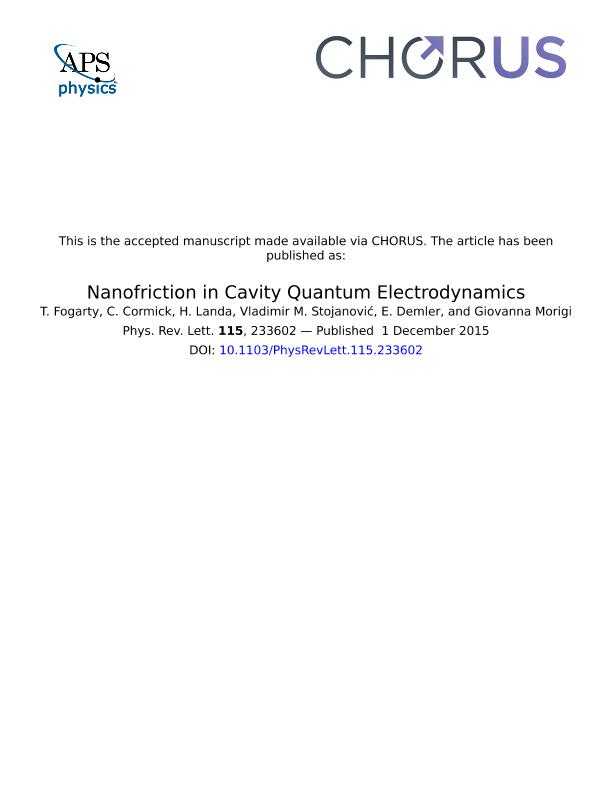Mostrar el registro sencillo del ítem
dc.contributor.author
Fogarty, T.
dc.contributor.author
Cormick, Maria Cecilia

dc.contributor.author
Landa, H.
dc.contributor.author
Stojanovic, Vladimir M.
dc.contributor.author
Demler, E.
dc.contributor.author
Morigi, Giovanna
dc.date.available
2018-07-16T18:40:59Z
dc.date.issued
2015-12-01
dc.identifier.citation
Fogarty, T.; Cormick, Maria Cecilia; Landa, H.; Stojanovic, Vladimir M.; Demler, E.; et al.; Nanofriction in Cavity Quantum Electrodynamics; American Physical Society; Physical Review Letters; 115; 23; 1-12-2015; 233602-233602
dc.identifier.issn
0031-9007
dc.identifier.uri
http://hdl.handle.net/11336/52249
dc.description.abstract
The dynamics of cold trapped ions in a high-finesse resonator results from the interplay between the long-range Coulomb repulsion and the cavity-induced interactions. The latter are due to multiple scatterings of laser photons inside the cavity and become relevant when the laser pump is sufficiently strong to overcome photon decay. We study the stationary states of ions coupled with a mode of a standing-wave cavity as a function of the cavity and laser parameters, when the typical length scales of the two self-organizing processes, Coulomb crystallization and photon-mediated interactions, are incommensurate. The dynamics are frustrated and in specific limiting cases can be cast in terms of the Frenkel-Kontorova model, which reproduces features of friction in one dimension. We numerically recover the sliding and pinned phases. For strong cavity nonlinearities, they are in general separated by bistable regions where superlubric and stick-slip dynamics coexist. The cavity, moreover, acts as a thermal reservoir and can cool the chain vibrations to temperatures controlled by the cavity parameters and by the ions' phase. These features are imprinted in the radiation emitted by the cavity, which is readily measurable in state-of-the-art setups of cavity quantum electrodynamics.
dc.format
application/pdf
dc.language.iso
eng
dc.publisher
American Physical Society

dc.rights
info:eu-repo/semantics/openAccess
dc.rights.uri
https://creativecommons.org/licenses/by/2.5/ar/
dc.subject
Trapped Ions
dc.subject
Optical Resonators
dc.subject
Friction Models
dc.subject
Long-Range Interactions
dc.subject.classification
Astronomía

dc.subject.classification
Ciencias Físicas

dc.subject.classification
CIENCIAS NATURALES Y EXACTAS

dc.title
Nanofriction in Cavity Quantum Electrodynamics
dc.type
info:eu-repo/semantics/article
dc.type
info:ar-repo/semantics/artículo
dc.type
info:eu-repo/semantics/publishedVersion
dc.date.updated
2018-07-03T21:55:15Z
dc.identifier.eissn
1079-7114
dc.journal.volume
115
dc.journal.number
23
dc.journal.pagination
233602-233602
dc.journal.pais
Estados Unidos

dc.journal.ciudad
Nueva York
dc.description.fil
Fil: Fogarty, T.. Universitat Saarland; Alemania
dc.description.fil
Fil: Cormick, Maria Cecilia. Consejo Nacional de Investigaciones Científicas y Técnicas. Centro Científico Tecnológico Conicet - Córdoba. Instituto de Física Enrique Gaviola. Universidad Nacional de Córdoba. Instituto de Física Enrique Gaviola; Argentina
dc.description.fil
Fil: Landa, H.. Université Paris Sud; Francia
dc.description.fil
Fil: Stojanovic, Vladimir M.. Harvard University; Estados Unidos
dc.description.fil
Fil: Demler, E.. Harvard University; Estados Unidos
dc.description.fil
Fil: Morigi, Giovanna. Universitat Saarland; Alemania
dc.journal.title
Physical Review Letters

dc.relation.alternativeid
info:eu-repo/semantics/altIdentifier/url/https://journals.aps.org/prl/abstract/10.1103/PhysRevLett.115.233602
dc.relation.alternativeid
info:eu-repo/semantics/altIdentifier/doi/http://doi.org/10.1103/PhysRevLett.115.233602
Archivos asociados
